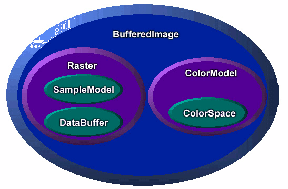Java 2D API: 5 - - JDK 5 Documentation v1.4.1, Java 2 SDK 英文文档
| CONTENTS | PREV | NEXT | Java 2D API |
5.2 Immediate Mode Imaging Concepts
The immediate mode imaging model supports fixed-resolution images stored in memory. The model also supports filtering operations on image data. A number of classes and interfaces are used in this model.
As shown in Figure 5-1, BufferedImage provides general image management. A BufferedImage can be created directly in memory and used to hold and manipulate image data retrieved from a file or URL. A BufferedImage can be displayed using any Graphics2D object for a screen device, or rendered to any other destination using appropriate Graphics2D context. A BufferedImage object contains two other objects: a Raster and a ColorModel.The Raster class provides image data management. It represents the rectangular coordinates of the image, maintains image data in memory, and provides a mechanism for creating multiple subimages from a single image data buffer. It also provides methods for accessing specific pixels within an image. A Raster object contains two other objects, a DataBuffer and a SampleModel.
The DataBuffer class holds pixel data in memory.
The SampleModel class interprets data in the buffer and provides it as individual pixels or rectangular ranges of pixels.
The ColorModel class provides a color interpretation of pixel data provided by the image's sample model.
The image package provides additional classes that define filtering operations on BufferedImage and Raster objects. Each image processing operation is embodied in a class that implements the BufferedImageOp interface, the RasterOp interface, or both interfaces. The operation class defines filter methods that performs the actual image manipulation.
Figure 5-2 illustrates the basic model for Java 2DTM API image processing:
The operations supported include:
Note that if you're interested just in displaying and manipulating images, you only need to understand the BufferedImage class and the filtering operation classes. On the other hand, if you're planning to write filters or otherwise directly access image data, you'll need to understand the classes associated with BufferedImage.
5.2.1 Terminology
Here are some terms used throughout the following discussions:Data Elements: primitive types used as units of storage of image data. Data elements are individual members of a DataBuffer array. The layout of elements in the data buffer is independent of the interpretation of the data as pixels by an image's SampleModel.
Samples: distinct members of the pixels of an image. A SampleModel provides a mechanism for converting elements in the DataBuffer to pixels and their samples. The samples of a pixel may represent primary values in a particular color model. For example, a pixel in an RGB color model consists of three samples: red, green, and blue.
Components: values of pixels independent of color interpretation. The distinction between component and sample is useful with IndexColorModel, where pixel components are indexes into the LookupTable.
Band: the set of all samples of one type in an image, such as all red samples or all green samples. Pixel data can be stored in a number of ways, the two supported in the Java 2D API being banded and pixel interleaved. Banded storage organizes image data by bands, and a pixel is made up of sample data from the same position in each band. Pixel interleaved storage organizes image data by pixels, with a single array containing all pixels, and bands consisting of the set of samples at the same index position in each pixel.
Primaries: distinct members of a color value in a specific color model; for example the RGB model forms color values from the primaries red, green, and blue.
CONTENTS | PREV | NEXT
Copyright © 1997-2001 Sun Microsystems, Inc. All Rights Reserved.


